| Maat-ka-Ra Hatshepsut |
|
2. Portico (Hall of Punt) |
update: 29.08.2010 |
| Two rows with 11 rectangular pillars each - as in all other wings - form the front of the left wing towards the middle terrace. The relief describes with almost scientific ambition the commercial expedition to the country Punt which was accomplished in regnal year 9 of Hatshepsut. The representations start at the lower register on the southern side of the rear wall, turn thereafter to the lower part of the southern short wall, and run back then in the upper registers on the rear wall again. |

| The diagram above shows the arrangement of the scenes in the Hall of Punt. In former times it was possible to view individual scenes from the rear (i.e. 2nd) row of pillars, approx. from a distance of about 1 m. Since the winter season 2001/2002 the entrance to both wings of the portico is blocked by new railings on the outer row of pillars. These railings were especially installed to protect the relief on the pillars, however, they make the inspection of the relief more difficult. |
|
Therefore, the sequence of the scenes is given below with the help of the
numbers:
1 - the fleet arrives in Punt 2 - the expedition is welcomed in Punt 3 - exchange of gifts, above No. 3 men carry trees including the root-stocks 4 - ships are loaded with the "tribute" of Punt 5 - return of the expedition 6 - gifts for the Lord of Punt 7 - Hatshepsut presents gifts from Punt to Amun 7a - Hatshepsut 7b - three large trees 8 - Weighing and Counting 8a - piled myrrh between registers 8 und 9 there is only text 9 - the success of the expedition to Punt is announced to (in front of) Amun 9a - Thutmosis III offers incense before Amun 9b - Hatshepsut standing in front of Amun 9c - Amun seated on his throne 10 - the success of the expedition is announced at the royal court |
|
However, in Egyptian history this was not the first expedition to Punt, already in the
Old and in the Middle Kingdom
expeditions by ship were successfully sent to Punt (e.g. in the Middle Kingdom
by Mentuhotep II, Senwosret I and Amenemhet II). Punt itself could not be located with
certainty so far, however, it have been might located
at the east coast of Africa (I have arranged a summary of the
literature concerning the localization of Punt
on an own page). Based on the animals and plants
depicted in the relief Punt possibly was somewhere in the area from the Sudan down to the Somali
coast. Starting point of the sea journey was most likely a port in the area of Quseir at the Red Sea which was reached from Coptos on a road through the desert. In general opinion the Egyptians were not good sailors. If one agrees then the expedition southward along the East African coast to Punt might have been equivalent to the feat and of course the adventure of Spanish and Portuguese sailors on their search for the sea route to India in the ending Middle Ages. However, as demonstrated by the results of the expedition sent by Hatshepsut the effort and the risk were more than balanced, because later kings such as Thutmosis III and Amenhotep III again sent expeditions to Punt. |
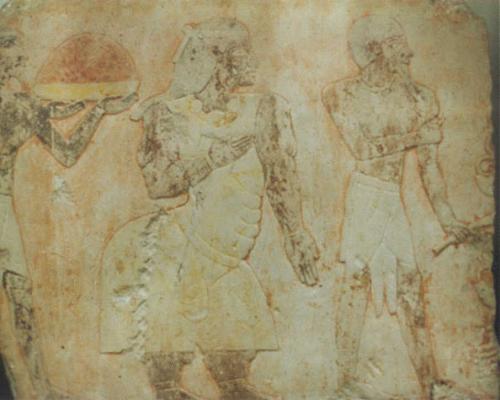
| The famous queen of Punt, Itj; photo of the original that is exhibited in the Museum at Cairo (No. 34419), at Deir el-Bahari a copy was inserted in the relief |
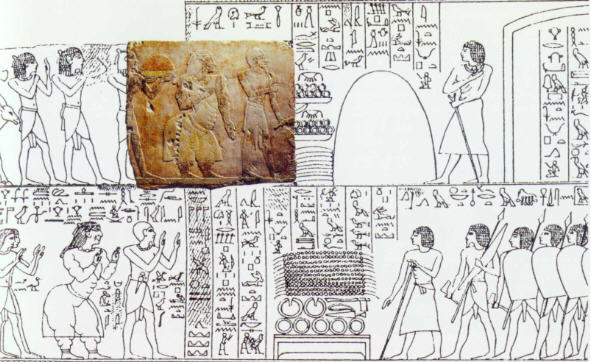
| The drawing above shows how the plate with the queen of Punt fits into the surrounding scenes of the relief (according to Wilkinson, 2000), the right part of the scene showing in the lower register the envoy Nehesj in front of Egyptian solders is also presented on a photo below |
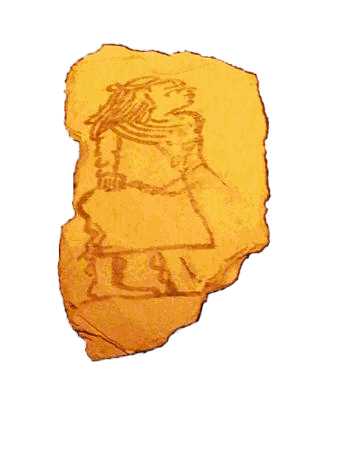
| The portrayal of the queen of Punt, Itj, was obviously so fascinating for the old Egyptians that - probably in Ramessid times - an artist made a copy of the appropriate relief on a piece of limestone (H: 14 cm, B: 8 cm) which he took along. The ostracon above was found in or near the workers' housing estate at Deir el-Medine and is today on show in the Egyptian Museum, Berlin, No. 21442 |
|
Of course such a journey was not undertaken without the benediction of the gods. For the expedition to Punt started by Hatshepsut Amun himself gave the order and guaranteed a successful journey. The successful journey certainly increased the reputation of the queen which in turn testified at the same time that her reign was blessed by the gods and was in conformity with the "Ma'at". Therefore, it was quite logical that Hatshepsut let record this important event in Deir el-Bahari. With regard to the spatial arrangement in the 2. portico, the expedition to Punt was given a comparable importance as to her presentation of her "Myth of Birth". |
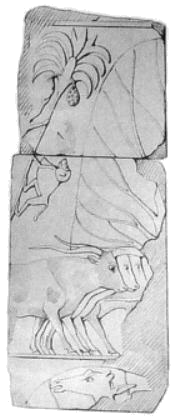 |
Deviating from the otherwise usual
canonized representation on Egyptian buildings the journey is
represented very realistic, one has the feeling as if the artists
had taken part in the journey and had seen themselves the native population, animals, plants and the
stout queen. These masterly representations found numerous "lovers", so that soon after opening by Mariette of the temple (1858; still in the first year of his announcement as a curator of all Egyptian monuments) the wall was plundered and exhibits today numerous gaps. The block with the queen of Punt, Itj, (shown above) is the only one of her illustrations which had been left. Therefore, the block was brought into the Museum of Cairo and a reproduction was inserted in the corresponding wall of the temple. (left a scene in Punt, drawing by Naville, 1894 - 1908) |
| The text above the sailing 5 ships whose bow points
southwards mentions the tasks of the expedition (see below), however,
the text does not contain any information about the journey to Punt except that one
had got in
peace to Punt. |
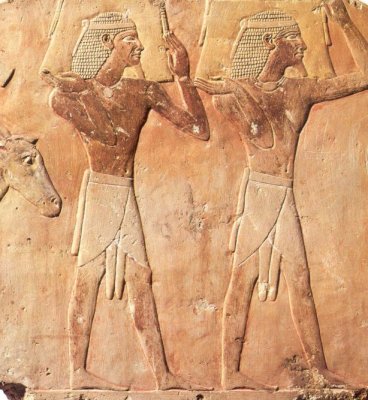
| Above a part of the relief showing how the goods desired by the Egyptians are brought by people who lived in Punt and by donkeys. Like the picture of the queen this part had been stolen from the temple but could be regained. Thereafter, the original was kept as a precaution in the Museum in Cairo and a copy was inserted at Deir el-Bahari. |
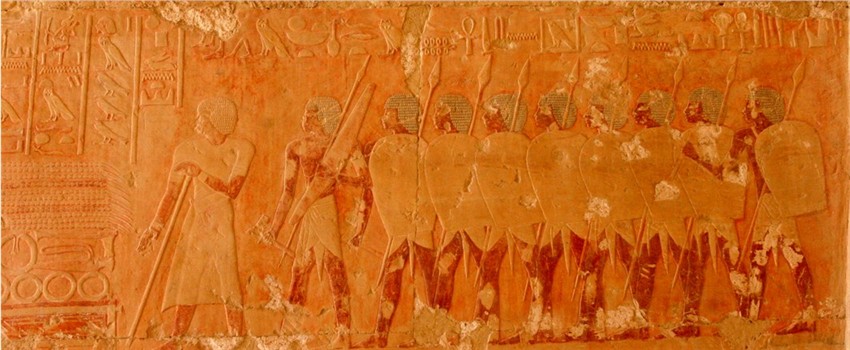
| The envoy Nehesj with a group of solders in front of piled gifts for the lord of Punt |
| Among other things the main interest of the Egyptians had been the acquisition of valuable resins. Myrrh (Commiphora myrrha) and incense (Boswellia carterii) which were needed for the production of censing means. These were burned in quantities during the daily temple rituals, in addition, they were used during the mummification process and even as a medicine. Small pills of myrrh were chewed e.g. to alleviate bad breath. In Egypt, poor in trees, only very small sorts of myrrh were grown. Therefore, Nehesj had not only the order to bring along from Punt the desired resins but also complete tree (see the following illustration) which were then cultivated in the temples of Amun. At Deir el-Bahari on the right of and left side in front of the 1. ramp leading to the middle terrace the stumps of trees were found around T-shaped basins - it is assumed that these are the remnants of the trees which were brought from Punt. |
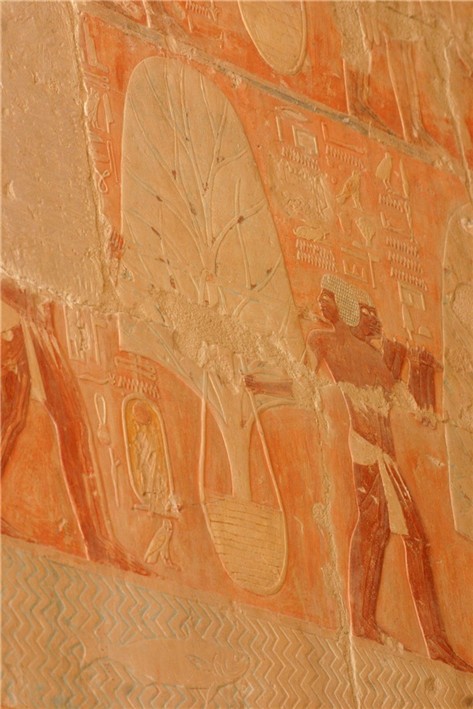 |
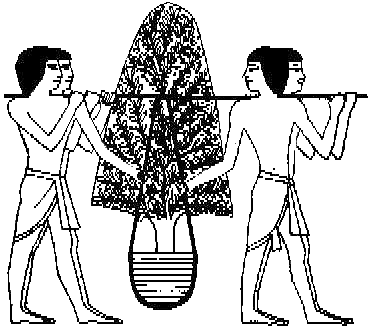 |
| Egyptians carry a tree including its rootstock from Punt; on the left the relief, on the right a drawing of a comparable scene; taken from: Tyldesley, Hatshepsut - the female Pharao, 1996 |
| As Edel (1984) showed (in an anniversary publication for Helck) by a new analysis of a text of Hrw-xwjf (= Herchuf = Harkhuf who lived during the reign of Pepi II, 6. Dynasty) which was well-known for a long time, there were among others some highly desired products of Punt which were used as perfume (the hands). Therefore, all products, which brought along from the country JAm by Hrw-xwjf could be purchased also from Punt. In a comparison of different texts, among them inscriptions from the tomb of cA-rnpwt I (Sa-renput I in Qubbet el-Hawa, Aswan, 12. Dynasty during the reign of Senwosret I), the inscriptions of Hatshepsut about Punt, the fairy tale of the shipwrecked sailor, etc. Edel listed the following products which came from Punt: |
| Herchuf | Hatshepsut | shipwrecked sailor | |
| Olibanum | snTr | snTr | sntr |
| Ebony | hbnj | hbnj | - |
| "Praise" = one of the 7 holy oils | Hknw | - | Hknw |
| aromatic product that was offered after meals for smelling or for use as a perfume | SsAt | xs(A)yt | xs(A)yt |
| Fur of Cheetahs | bA | jnmw njw Aby Sma | - |
| Tusk (mswA = nDHt ) of Elephants / Ivory) | mswA Abw | Abw | nDHt nt Abw |
| Boomerang from Punt | TnjA | amaA(w)t njw Pwntjw | - |
| Directly after the scene with the sailing ships the following relief already show the
arrival at Punt where the Egyptians trace a village, surrounded by a forest
of palms, ebony and trees of myrrh. The following scenes show
the welcome by the friendly native population.
Very realistic the scenes show the customary conical lake dwellings (see below) and the native animal species (among them cattle, watchdogs, panther or leopards; possibly, a very damaged picture also showed a rhinoceros). Nehesj, accompanied by soldiers and their officer, was friendly welcomed by the chief (prince Parahu, PArAhw) and his family (his wife Itj, his daughter and 2 sons). The chief is depicted more fair-skinned than the other inhabitants of the village, nearly like an Egyptian, but a goatee beard and rings around the legs identify him as stranger. His corpulent wife (see the illustration above) with her wobbly figure and emerging adipose backside surely affected the Egyptians very strangely. Since she obviously had problems to walk, she was riding on a small donkey, however, how she got up the ladder into the house is not reported. The gifts brought along by Nehesj (among other things jewelry, an axe, a dagger) strengthen the friendly relations with the inhabitant so much that Nehesj finally welcomed the chief at a banquet in his tent. |
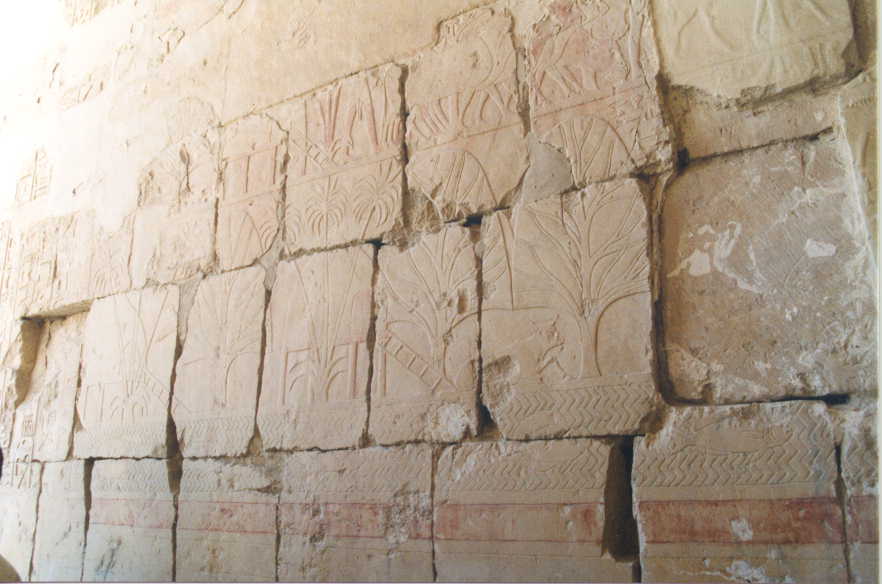
| Landscape from Punt with lake dwellings (in the center of the relief one recognizes the ladder); below the hut a river (just above the red band) and, therein, several fishes (e.g. in the last complete block right) and a turtle (in the water above the 3rd lower block) |
| The Egyptians obviously stood several weeks ashore and led by natives probably undertook also longer expeditions to the hinterland, in order to get ebony and myrrh. Perhaps, this may have been an "obligation stay" to wait for fair winds which allowed them to return to Egypt. The next relief shows the loading of the ships for the return journey (see drawing below), however, about which next to noting is reported as about the journey there. |
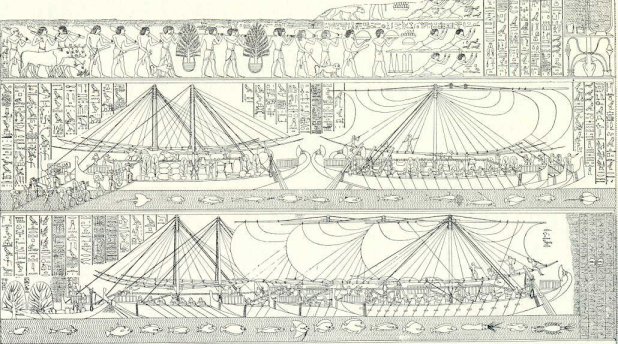
|
|
The Punt fleet of Hatshepsut in Deir el-Bahari; on the left upper register the ships are loaded (from: Saeve-Söderbergh, T., "The Navy of the Eighteenth Egyptian Dynasty", Uppsala Universitets Årsskrift, 1946). Below the ships several different marine animals are depicted which should have lived in the sea near Punt (see also: localization of Punt). |
| The following registers already show the arrival and
the unloading of the ships at Thebes in presence of Hatshepsut. Since
there was no connection from the Red Sea to the Nile, it is remains questionable, how the ships
reached Thebes. Possibly, they were dismantled at the Red Sea port and transported
on a desert road to the Nile (both on the way there on back?): On the other hand the
relief shows perhaps only the ships which brought the treasures on the Nile
from Coptos to Thebes. In the papyrus Harris I dated into the time of
Ramses III (20. Dynasty) is reported, how, the goods were reloaded on carriers and donkeys,
loaded again on ships at Coptos with which they were then
transported down the Nile (in this case the destination cannot have been Thebes).
The most valuable part of the goods brought along Hatshepsut, in presence of Nehesj and Senenmut standing beside him, offered proudly to her "father" Amun. The figures of Hatshepsut, Nehesj and Senenmut as well as an important part of the texts were already chiseled out in antiquity. Now Thutmosis III wearing the Khepresch crown appears in front of Amun offering two jars of myrrh (see photo below). These changes were probably part of the usurpation by Thutmosis III. |
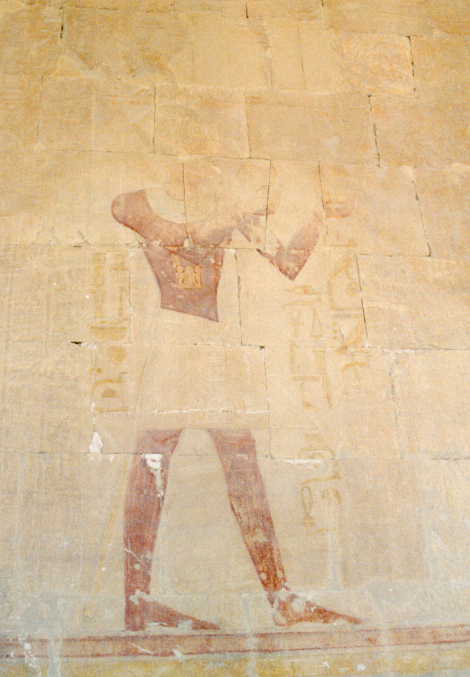
| The presentation of the journey to Punt ends with the announcement of the successful return in front of the complete royal court. The following picture shows Hatshepsut sitting on her throne during that announcement, behind her her ka is depicted. |
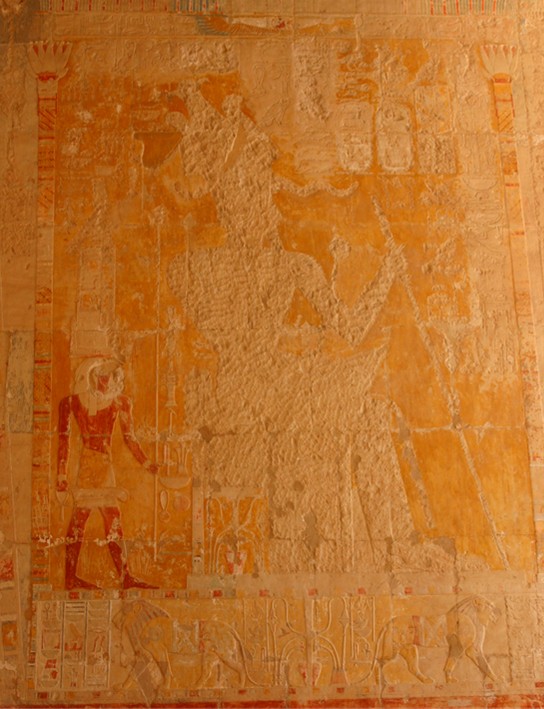
| The throne is completely carried by lions walking in opposite directions, one of them is shown in detail in the next picture. |
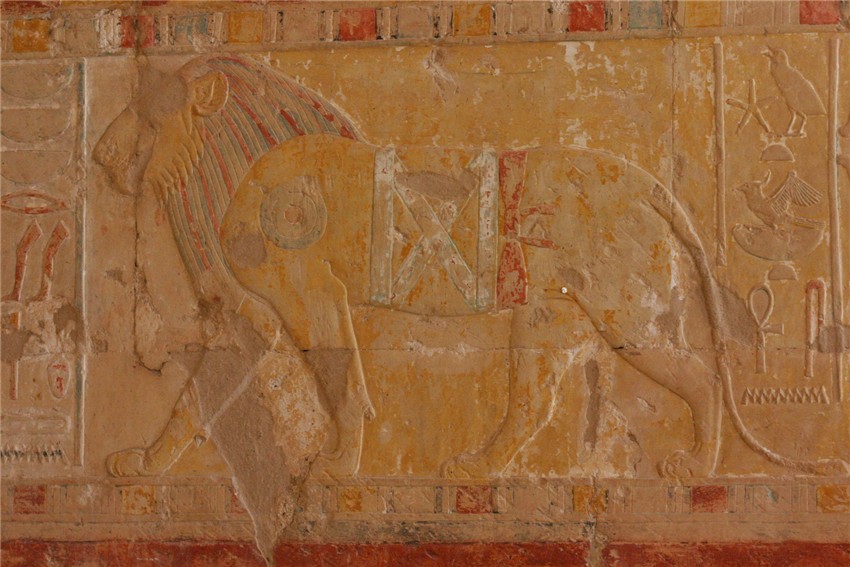
| Djeser djeseru | Location of the Monument | History | Djeser djeseru - the times after |